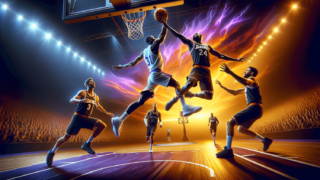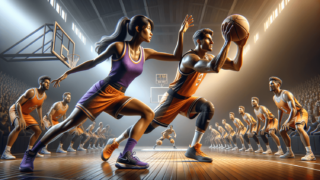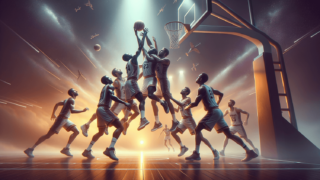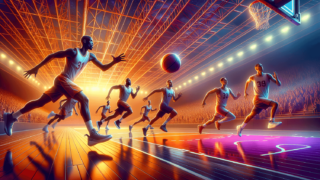
Welcome to the fascinating world of basketball, where verticality reigns supreme! In this exciting blog post, we’ll explore the ups and downs in basketball – from soaring dunks and gravity-defying jump shots to fundamental defensive strategies and the secret to snagging those crucial rebounds. So whether you’re an aspiring baller or a seasoned hoops enthusiast, get ready to elevate your knowledge as we break down the ins and outs of taking your game to new heights, while maintaining solid footing on both ends of the court. Join us as we dissect the intricate dance between rising stars and sinking fortunes, making sure you uncover every nuance of this exhilarating sport along the way.
What Is Up and Down in Basketball?
Up and down in basketball refers to the vertical aspects of the game, including jumping ability, shot trajectory, and rebounding control. These elements play a vital role in both offensive and defensive success, requiring athletes to balance physical prowess, strategic thinking, and fundamental skills. Mastering the ups and downs in basketball is essential for overall performance and contributes to a player’s ability to dominate on the court.
Mastering the Art of the Vertical Leap
One of the most exhilarating aspects of basketball is the vertical leap – a showcase of sheer athletic ability and a key factor in several aspects of the game. Let’s jump right into understanding the significance of a high jump and how to improve yours.
Why is a strong vertical leap important?
From sky-high dunks to aggressive rebounding, height advantage is undeniably important in the game of basketball. Possessing a strong vertical leap can improve your overall performance in various areas, such as:
- Scoring: Being able to jump higher allows you to shoot over taller defenders or make crowd-pleasing dunks.
- Rebounding: The battle for rebounds often comes down to who can get off the ground quickest and reach the highest.
- Shot blocking: A higher jump gives you a better chance of swatting away opponents’ shots.
- Steals: Leaping ability can help you intercept passes and poke balls loose from offensive players.
Tips to improve your vertical leap
While natural athletic prowess can contribute to a higher leap, consistent training and key exercises can significantly enhance your vertical abilities. Here are some tips to help you elevate your game:
- Strength training: Focus on exercises that target your lower body, specifically your quadriceps, hamstrings, and calves. Squats, lunges, leg press, and calf raises are a great start.
- Plyometrics: Plyometric exercises like box jumps, depth jumps, and single-leg bounds can rapidly increase your jumping height by improving your leg muscles’ explosiveness.
- Flexibility: Stretching regularly and working on your flexibility can enhance your vertical leap by expanding your muscles’ full range of motion.
- Technique: Perfect your jumping technique by practicing regularly, ensuring proper foot placement, and engaging your core throughout the jump.
Unlocking the Power of the Jump Shot
Equally important in the realm of the vertical game is the art of the jump shot. This essential offensive weapon can make or break a team’s scoring abilities, often being the difference between victory and defeat. Let’s explore the mechanics and intricacies of this crucial skill.
Components of an effective jump shot
When it comes to mastering your jump shot, proper form and technique are key. Here are the essential components to ensure your shots are accurate and consistent:
- Balance: Your jump should be well-balanced and controlled, with a solid foundation of good footwork and appropriate weight distribution.
- Hand positioning: Place your non-shooting hand on the side of the ball for support and your shooting hand on the back, with your palm facing the basket.
- Elbow alignment: Keep your shooting arm’s elbow aligned under the basketball, allowing for a smooth, straight shot trajectory.
- Shooting wrist: Develop a consistent wrist flick, releasing the ball with a gentle snap motion to generate the desired backspin.
- Follow-through: Maintain a fluid motion while releasing the ball, extending your shooting arm and keeping your fingers pointed towards the basket.
Exercises and drills to elevate your jump shot
Practice makes perfect, especially when it comes to nailing your jump shot. Here are several exercises and drills to help you reach your basketball shooting potential:
- Form shooting: Stand close to the hoop, focusing on perfecting your shooting mechanics without jumping. This will build muscle memory and shooting consistency.
- Spot shooting: Select different spots on the court to practice your jump shot, emphasizing proper form and footwork in each location.
- Shooting off the dribble: Incorporate dribbling into your shooting routine, simulating game situations and improving your ability to get open shots off the bounce.
- Contested shooting: Practice shooting with a defender, either a teammate or a simple training aid, to simulate realistic game scenarios and train under pressure.
Rebounding: The Unsung Hero of Basketball Success
While dunks and jump shots may steal the show, any seasoned basketball enthusiast knows that controlling the glass is vital for success. Let’s break down the art of rebounding and how it can make or break your team’s performance.
Types of rebounds
Each rebounding situation demands unique skills and body positioning. Here are the two primary types of rebounds and strategies to snag them:
- Offensive rebounds: When your team misses a shot, securing an offensive rebound provides a second-chance scoring opportunity. Position yourself close to the basket or under your defender, using box-out techniques to maximize your chances of securing the ball.
- Defensive rebounds: These are pivotal in limiting opponents’ scoring chances. Anticipate the ball’s trajectory, positioning yourself between the basket and your opponent while maintaining a strong box-out stance.
Tips for honing your rebounding skills
Becoming a relentless rebounder requires both physical prowess and strategic thinking. Here are some pointers to dominate the boards:
- Anticipation: Develop your ability to anticipate where the ball is headed, directing you to the right spot for the rebound.
- Boxing out: Master the technique of boxing out your opponent, using your lower body to create space between them and the ball.
- Jumping: Enhance your vertical leap and timing to out-jump the competition.
- Strength and conditioning: Focus on building strength and endurance, enabling you to endure the physical battle for rebounds throughout the game.
Defense: The Key to Controlling the Up and Down Game
Defensive prowess is crucial when it comes to stifling high-flyers and controlling the vertical aspects of basketball. Let’s analyze defensive strategies and techniques that can elevate your team’s performance.
Shot blocking and shot contesting
Proper shot blocking and contesting can intimidate opponents and disrupt their offensive rhythm. Here are the essential elements for effectively challenging shots:
- Anticipation: Learn to read the offensive player’s movements, positioning yourself to challenge their shot without committing to easy fouls.
- Timing: Perfect your timing to leap and attempt a block without leaving your feet too early or giving up easy baskets.
- Verticality: Maintain a straight-up posture while challenging shots, directing contact with the offensive player through your torso.
- Awareness: Be mindful of your team’s defensive scheme, ensuring you don’t abandon your defensive assignment or leave a teammate exposed.
Defending the jump shot
Effectively defending a jump shooter requires not only physical ability but also strong positioning and anticipation. Here are some pointers for smothering their attempts from beyond the arc:
- Closeouts: Execute an efficient closeout, giving yourself ample space to both deter drives and contest shots.
- Contesting: When the shooter elevates for a shot, jump to contest the attempt without fouling or overcommitting to the block.
- Footwork: Develop nimble footwork, enabling you to quickly change directions and stay right up against the jump shooter.
- Communication: Maintain constant communication with your teammates, calling out screens and switches to limit open looks for opponents.
The Mental Game: Unearthing the Up and Down Dynamics
Beyond the physical game, basketball’s up and down dynamics are also critical on a psychological level.
Confidence in shooting
While physically mastering mechanics is essential, adopting a confident mindset can carry your jump shooting to new heights. Some tips for developing unwavering confidence include:
- Visualization: Spend time visualizing yourself successfully making jump shots, promoting self-belief in real-game situations.
- Trusting practice: Remember time spent refining your skills, drawing confidence from your dedication off the court.
- Positive self-talk: Combat negative thoughts with affirmations, reinforcing your belief in your abilities even during difficult shooting stretches.
Resilience
In basketball, as in life, there will be ups and downs. Building mental resilience can help you overcome adversity and excel on the court. Cultivate resilience by:
- Embracing challenges: Use game setbacks as opportunities for growth, seeking out corrective action and learning experiences.
- Mental preparation: Develop pre-game routines, reminding yourself of your strengths and recent successes.
- Focusing on the present: Stay in the moment, letting go of past mistakes and refocusing your energy on the task at hand.
- Exploiting Mismatches and the Importance of Versatility
Basketball is a game of mismatches, and the up and down nature plays a significant role in creating advantageous situations. Recognizing and exploiting these mismatches can help you gain a competitive edge, both offensively and defensively.
Offensive mismatches
Offensively, mismatches can be created by forcing defenders to guard players of different heights, strengths or skill levels. Some strategies to create mismatches include:
- Pick and roll: Initiate a pick and roll play that might force a slower big man to switch onto a quicker guard, or vice versa, allowing the offensive player to exploit the height or speed difference.
- Post-ups: Identify an opposing guard who has been forced to defend a taller player, then pass the ball to that player in the low post, where they can take advantage of their height.
- Isolation: Clear out one side of the court, leaving room for your best offensive player to work one-on-one against a weaker defender.
Defensive mismatches
On the defensive end, being able to guard multiple positions and minimize the impact of mismatches is increasingly important. To counter mismatches when defending, consider the following:
- Switching: In situations where a screen is set, the defensive players may elect to switch assignments, allowing a more suitable defender to guard the ball-handler.
- Help defense: If a teammate is caught in a mismatch, providing prompt help defense can reduce the scoring chances for the opposing team.
- Defensive versatility: Develop the ability to guard multiple positions on the court, improving your overall defensive impact and potential to neutralize mismatches.
Incorporating Height and Length in Basketball
The up and down elements of basketball also incorporate height and length, as taller players can be highly effective in various roles on a team. Let’s examine the value of height and length in basketball and how to maximize their advantages.
Utilizing height and length offensively
Height and length can have a significant impact on the offensive end of the court, providing various advantages:
- Shooting over defenders: Taller players can often shoot over smaller defenders with relative ease, increasing the likelihood of scoring.
- Finishing at the rim: Height and length provide an advantage when finishing around the basket, as players can reach above rim level and avoid shot-blockers.
- Operating in the post: Taller players can establish deep post position, making it easier to score on low-post moves or pass out to open teammates.
Maximizing height and length defensively
Defensively, height and length can be game-changing factors. The advantages include:
- Shot-blocking: Taller players can protect the rim by blocking or altering shots, reducing opponents’ field goal percentages.
- Defensive rebounds: Height and length increase a player’s ability to grab defensive rebounds, limiting the opponent’s second-chance opportunities.
- Disrupting passes: Long arms can lead to deflections and steals, generating turnovers and sparking fast-break opportunities.
With a thorough understanding of the up and down dynamics in basketball, you can now apply these concepts on the court, analyze your favorite teams and players, and gain a deeper appreciation for the game’s intricacies. Master the vertical game and witness firsthand the impact it can have on both individual and team success.
Frequently Asked Questions
At this stage, you may have some questions related to the up and down dynamics in basketball. Here, we’ve compiled a list of common questions and provided concise, NLP-style answers to help you navigate this exciting component of the game.
1. How can I increase my vertical leap without going to the gym?
Focus on bodyweight exercises, such as squats, lunges, and calf raises, as well as plyometric training, like box jumps and depth jumps. Additionally, stretching for flexibility and practicing proper jumping technique can boost your vertical leap.
2. How can shorter players compensate for their lack of height in basketball?
Shorter players can excel by developing exceptional ball-handling, passing, and shooting skills. Quickness, agility, and basketball IQ can also help shorter players outsmart and outmaneuver taller opponents.
3. What are some key exercises for improving jump shooting?
Form shooting, spot shooting, shooting off the dribble, and contested shooting are all valuable exercises to incorporate into your practice routine to elevate your jump shooting abilities.
4. What’s the best way to practice rebounding?
Work on anticipation, boxing out, and timing in practice. Simulate game situations with teammates, focusing on positioning, jumping, and securing loose balls. Additionally, strengthen your legs and core muscles to improve your rebounding abilities.
5. How can I become a better shot blocker?
Improve your shot-blocking abilities by focusing on anticipation, timing, verticality, and maintaining proper defensive awareness. Consistent practice and studying the tendencies of opponents can help you excel in this area.
6. Can a player’s wingspan impact their performance in basketball?
Yes, a player’s wingspan can positively affect their performance by providing a larger reach for shot-blocking, steals, rebounds, and disrupting opponents’ passes on defense, while offensively helping with finishing around the rim and shooting over smaller defenders.
7. How can I improve my shooting confidence?
Develop unwavering confidence by visualizing successful jump shots, reminding yourself of your dedication to practice, and using positive self-talk to combat negative thoughts during shooting slumps.
8. What are the keys to contesting shots without fouling?
Master proper closeout techniques, maintain a straight-up posture, stay on your feet, and focus on disrupting the shot trajectory rather than swatting the ball away. Proper anticipation and positioning can help you contest shots without committing fouls.
9. How can I identify mismatches in a basketball game?
Mismatches can be recognized by observing differences in height, strength, or skill level between opposing players. Analyze the game and your marking assignments to identify potential mismatches that can be exploited, either offensively or defensively.
10. What role do centers and power forwards play in the up and down game of basketball?
Centers and power forwards typically have a significant impact on the up and down game, as their height, strength, and leaping ability make them vital for shot-blocking, rim protection, rebounding, and scoring on low-post moves or dunks.
11. How can a tall and athletic player maximize their impact on defense?
Tall and athletic players can maximize their defensive impact by focusing on shot-blocking, rim protection, aggressive rebounding, and utilizing their length to disrupt passing lanes, increase deflections, and force turnovers.
12. What is verticality in basketball?
Verticality refers to maintaining a straight-up posture while defending or attempting a shot block, minimizing the chance of fouling an opponent.
13. How can I develop better anticipation skills in basketball?
Gaining experience through consistent game play, studying opponents’ tendencies, and staying mentally engaged during games can all help improve your anticipation skills. Additionally, focusing on quick decision-making and staying poised under pressure is essential for anticipating the game’s next move.
Featured Posts
- No pillar pages found.





